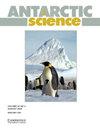Extremophile hypolithic communities in the Vestfold Hills, East Antarctica
IF 2
4区 地球科学
Q3 ENVIRONMENTAL SCIENCES
引用次数: 0
Abstract
The Vestfold Hills are a 400 km南极洲东部维斯特福尔丘陵的极端嗜下石群落
维斯特福尔德丘陵是南极洲东部一个面积为400平方公里的孤立无冰绿洲,这里有大片半透明的石英岩,为石下微生物群落提供了栖息地。我们利用 16S 和 18S 核糖体 RNA 扩增子的高通量 DNA 测序来描述整个维斯特福尔德丘陵的细菌和真核生物石下群落的特征。我们发现了群落结构的高水平局部异质性,这与基底石之间的有限散布是一致的。下石群落以异养细菌(平均细菌相对丰度:56%)和蓝藻(35%)为主,真核生物以叶绿体(43%)为主。土壤盐度(5%-7%)和水分供应量(8%-11%)解释了微生物群落组成和功能的变化,虽然所占比例很小,但却很重要,不同的盐度和水分供应量与不同的类群有关。此外,许多推断出的细菌代谢途径在来自干旱或高盐度地点的下石层群落中得到了丰富。维斯特福尔德丘陵下石栖息地很可能是细菌和真核生物多样性的本地庇护所。除了湖泊类型和峡湾作为潜在来源种群的数量和多样性之外,整个维斯特福尔德丘陵土壤盐度和水供应的梯度也可能是造成所观察到的嗜极端微生物、石下微生物群落组成变化的原因。
本文章由计算机程序翻译,如有差异,请以英文原文为准。
求助全文
约1分钟内获得全文
求助全文
来源期刊

Antarctic Science
地学-地球科学综合
CiteScore
3.60
自引率
6.20%
发文量
42
审稿时长
3 months
期刊介绍:
Antarctic Science provides a truly international forum for the broad spread of studies that increasingly characterise scientific research in the Antarctic. Whilst emphasising interdisciplinary work, the journal publishes papers from environmental management to biodiversity, from volcanoes to icebergs, and from oceanography to the upper atmosphere. No other journal covers such a wide range of Antarctic scientific studies. The journal attracts papers from all countries currently undertaking Antarctic research. It publishes both review and data papers with no limits on length, two-page short notes on technical developments and recent discoveries, and book reviews. These, together with an editorial discussing broader aspects of science, provide a rich and varied mixture of items to interest researchers in all areas of science. There are no page charges, or charges for colour, to authors publishing in the Journal. One issue each year is normally devoted to a specific theme or papers from a major meeting.
 求助内容:
求助内容: 应助结果提醒方式:
应助结果提醒方式:


